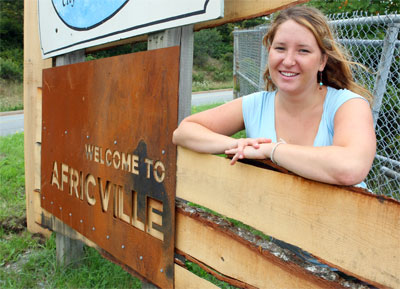 |
| Architecture student Magda Gawlik at the entrance to Seaview Park. (Nick Pearce Photo) |
The markers pointing out some of the significant places in the former community of Africville are made of cedar posts, sheets of rusted metal, and slabs of wood with the tree bark still attached. But while they look rough and make-shift, the markers are strong and should last for years.
‚ÄúThey may be tarnished and rusted on the surface, but there‚Äôs real strength underneath,‚Äù says Magda Gawlik, one of 10 ¬È∂π¥´√Ω architecture students who recently erected the markers in Seaview Park, on the shore of the Bedford Basin in Halifax.
MORE PHOTOS: Return to Africville
“They’re a reflection of Africville—here are all these scars and scratches and dents and rust, but it’s still a very strong community,” adds Shyronn Smardon, a fourth-year architecture student with a keen interest in Africville. “That steel will be there for a very, very long time, as will the community.”
Today, Seaview Park, in the shadow of the MacKay Bridge, is an off-leash dog park. But until it was razed in the mid-1960s in the name of urban development, it was known as Africville, a mostly black community on the northern edge of Halifax which had been settled for more than a century. Some of the 400 people who lived in the ragtag settlement had ancestral roots connecting them to African-American Loyalists, slaves belonging to British Loyalists and runaway slaves from the American south.
|
Africville was Irvine Carvery’s childhood home. He grew up in a two-storey wooden house a few paces away from where a marker indicates the former location of the community’s post office. As the president of the Africville Genealogy Society, he’s been working doggedly for years to bring recognition to the site and pressure the city to return the land to the people of Africville as part of a communal settlement.
He says the architecture students and their professor Kim Thompson initiated something society members meant to do themselves. Their project—one of several free labs designed to take learning outside of the classroom—happen to coincide with the 25th annual Africville reunion, held at the end of July. The students were welcomed by former residents and their descendants “with open arms.”
“Erecting signage reclaiming Africville is something we had identified in our five-year plan,” says Mr. Carvery, who was 13 years old when he and his family were moved from Africville into city housing on Brunswick Street. “The students met an immediate need.”
The project turned into a warm collaboration between students, former residents and descendants. The Dal students consulted with people attending the reunion of where the markers should stand and listened to stories about the place. Moms and dads and kids painted the place markers. And, after the reunion was over and most of the tents were packed up, more than 80 people returned to Seaview Park on July 31 when the students presented their project and celebrated its completion.
The project turned into much more than a class assignment. “Everyone went above and beyond what a free lab could be,” says Mr. Smardon. “We’d be there at night and back in the early morning. It turned into something we poured our hearts into.”
At the opening, the students felt buoyed by the hospitality and good wishes they received from the crowd. “People came up to and said ‘thank you.’ They said we should be proud,” says Ms. Gawlik.
Mr. Carvery believes the project is important for those who lived in Africville and for those too young to remember it.
“When we return to those grounds, we see it as it was. For us to see a marker and be in that place, it just reinforces that memory,” he says. “But it’s also important for the descendants, who don’t have that shared memory. When I’m talking with my grandchildren, they can visualize better now. There’s something tangible to really bring the point home for them.
“The memories of that place aren’t just our memories, they’re our ancestors’s too. We’re a continuation of that huge reservoir of memory that speaks to the spirit of Africville and the strong sense of community that was there.”
LINK: , CBC Archives
